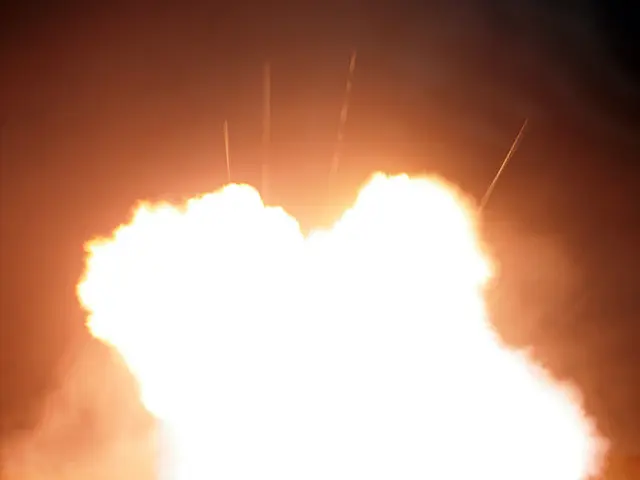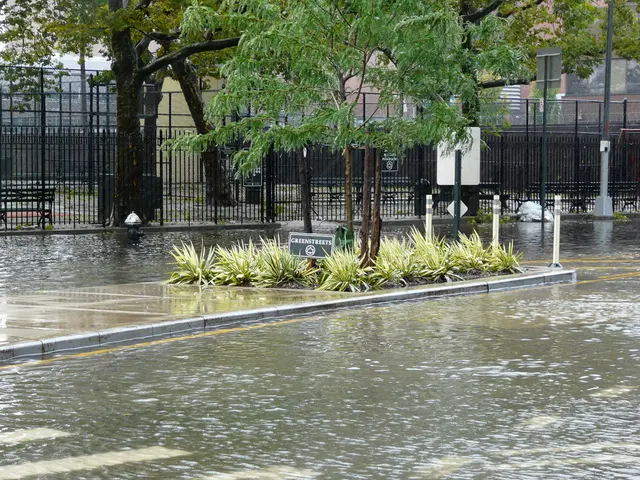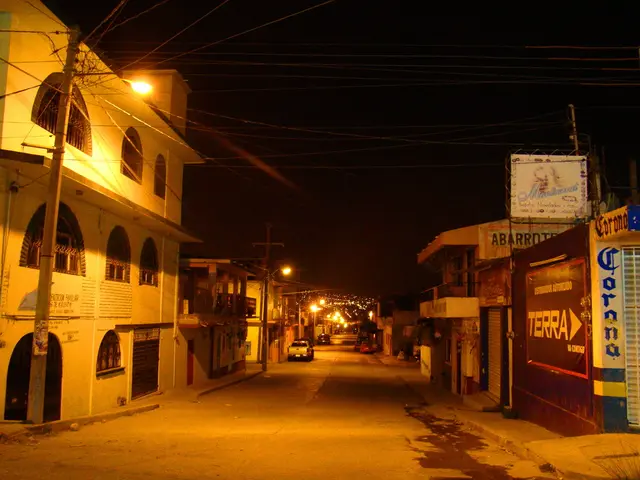Wildfires in Canada force evacuation of thousands across three provinces, potentially impacting air quality in certain American states.
Wildfire Chaos Across Canada:
Wildfires scorching central regions of Canada, particularly in provinces like Manitoba, are generating massive amounts of smoke that's heading south and disrupting air quality across a vast region of the U.S. [1][2][3]
Thousands of residents in multiple provinces have been forced to flee their homes due to the ongoing blazes. The bulk of evacuees reside in Manitoba, with approximately 17,000 residents evicted by Saturday, plus around 1,300 from Alberta, and about 8,000 from Saskatchewan. Authorities forecast more evacuations in Saskatchewan could follow. [1]
Visibility is reduced, and air quality poor, as a consequence of the smoke that's ventured into some U.S. states along the border. Saskatchewan's Public Safety Agency issued a warning on Sunday, emphasizing that rising smoke levels correspond with escalating health risks. [1]
More than 5,000 evacuated people came from Flin Flon, a city situated roughly 400 miles northwest of Winnipeg. The fire erupted a week ago near Creighton, Saskatchewan and hopped onto Manitoba territory, reportedly causing challenges for firefighting crews. Water bombers have been grounded due to dense smoke and an unwarranted drone presence. [1]
The American Department of Agriculture's Forest Service sent an air tanker to Alberta and pledged to provide 150 firefighters and equipment to Canada. [1]
In parts of the U.S., air quality fell to "unhealthy" levels on Sunday, in North Dakota, and small portions of Montana, Minnesota, and South Dakota, according to the U.S. Environmental Protection Agency's AirNow page. [1]
Bryan Jackson, a meteorologist with the National Weather Service in the U.S., expects more Canadian smoke to permeate the U.S. for the subsequent week. [1]
Canada's wildfire season runs between May and September, with the worst-ever season happening in 2023. The country subjected much of North America to perilous smoke for several months. [1]
Forecast Overview:
- Canada: More than 170 wildfires continue to burn, with over 90 being uncontrolled. [2][3]
- U.S. Air Quality Impacts: The smoke has already smudged the Upper Midwest, Plains, and portions of the Northeast, resulting in air quality alerts for millions. Some areas, such as Minnesota, have registered AQI (Air Quality Index) values ranging between 200 and 400, which denote unsafe-to-hazardous conditions for all groups. [2][4]
- Northeast (NYC, Tri-State): Smoke from the Canadian fires is anticipated to reach New York City and the surrounding area, primarily aloft, resulting in milky or hazy skies and fascinating sunrises or sunsets. However, the air quality is expected to remain mostly in the moderate range (AQI 51-100), albeit it still poses risks for sensitive groups like those with respiratory issues. The potential exists for enhanced AQI in specific locations if conditions worsen. [1]
- Weather and Future Outlook: Thunderstorms and scattered rain showers are predicted in central Canada during the following week, potentially mitigating the escalating drought situation but also carrying the risk of new fires initiated by lightning. Authorities do not foresee conditions significantly deteriorating in the short term, but repeated smoky periods are expected. [2]
Summary Table: Current and Forecast Air Quality Conditions
| Region | Expected AQI Range | Impact Level | Health Risks ||-----------------------|-------------------|----------------------|---------------------------------------|| Central Canada | N/A (evacuations) | Fire and smoke | Evacuations, health hazards || Upper Midwest (e.g., MN) | 200–400 | Unhealthy–Hazardous | All groups, esp. sensitive || Plains, Eastern US | Moderate–Unhealthy| Moderate–Unhealthy | Sensitive groups, possible for all || Northeast (NYC, Tri-State) | 51–100 | Moderate | Sensitive groups |
Key Points:
- Vulnerable Groups: Individuals with lung disease, asthma, or heart conditions are advised to restrict outdoor activities in regions subjected to air quality alerts. [2]
- Safety Tips: Authorities advise sealing windows and doors to prevent smoke from entering homes. [2]
In essence, smoke from the Canadian wildfires continues to degrade air quality across the central and eastern United States, presenting ongoing risks for sensitive groups and the potential for hazardous conditions in certain regions, particularly the Upper Midwest. [2][3][4] The situation is under close monitoring as weather patterns progress.
- Los Angeles' air quality worsened due to the wildfires in Canada, causing concern for the health of its residents.
- An opinion piece in the local environmental-science magazine argued that the culture in California should prioritize climate-change policies and effective wildfire management to prevent such incidents.
- The general-news channel reported a spike in crime-and-justice cases due to chaotic conditions resulting from the wildfires in California.
- In political discussions, the issue of improving infrastructure for wildfire response and prevention rose to the forefront, with science playing a crucial role in understanding the causes and solutions.
- Scientists warned that the ongoing wildfires in California contribute to environmental damage, potentially exacerbating the fragile balance within its unique ecosystems.
- As the wildfire chaos continued, accidents occurred frequently on the roads that were already congested with evacuees, further complicating the situation.
- News outlets from across the nation kept a watchful eye on the wildfires in California, emphasizing the importance of timely and accurate reporting to inform the public and help them stay safe.








